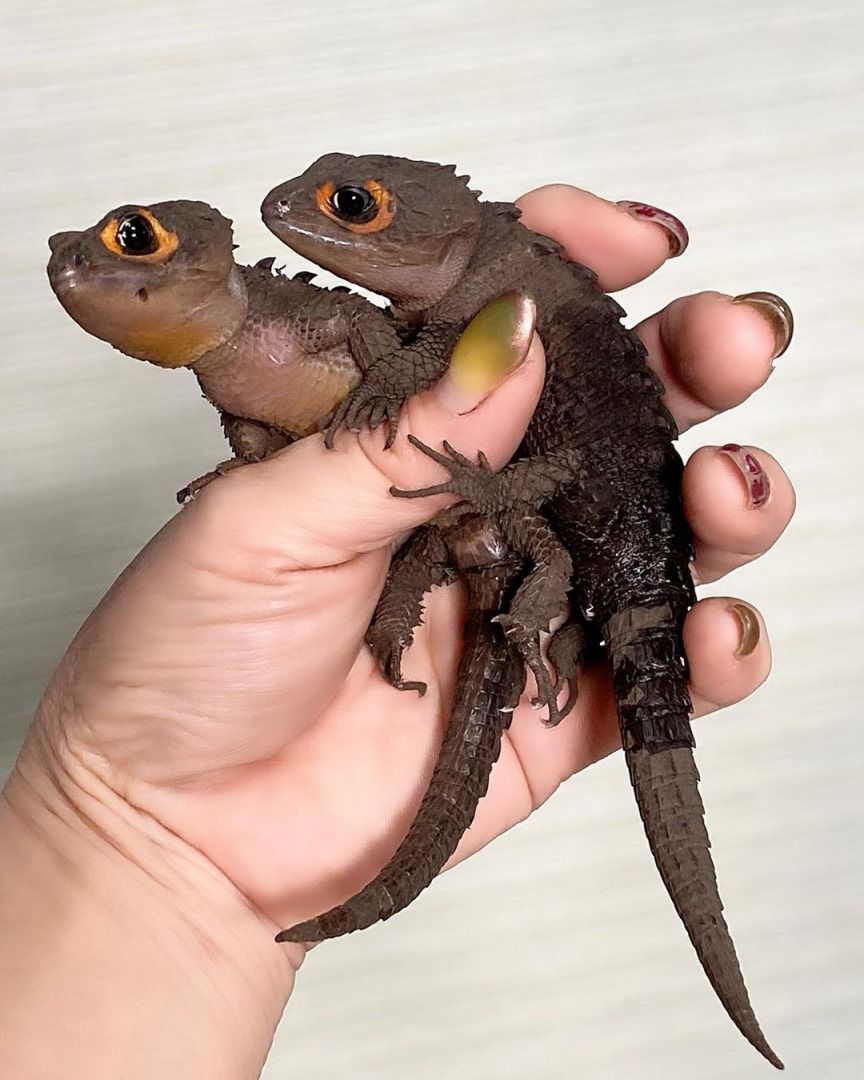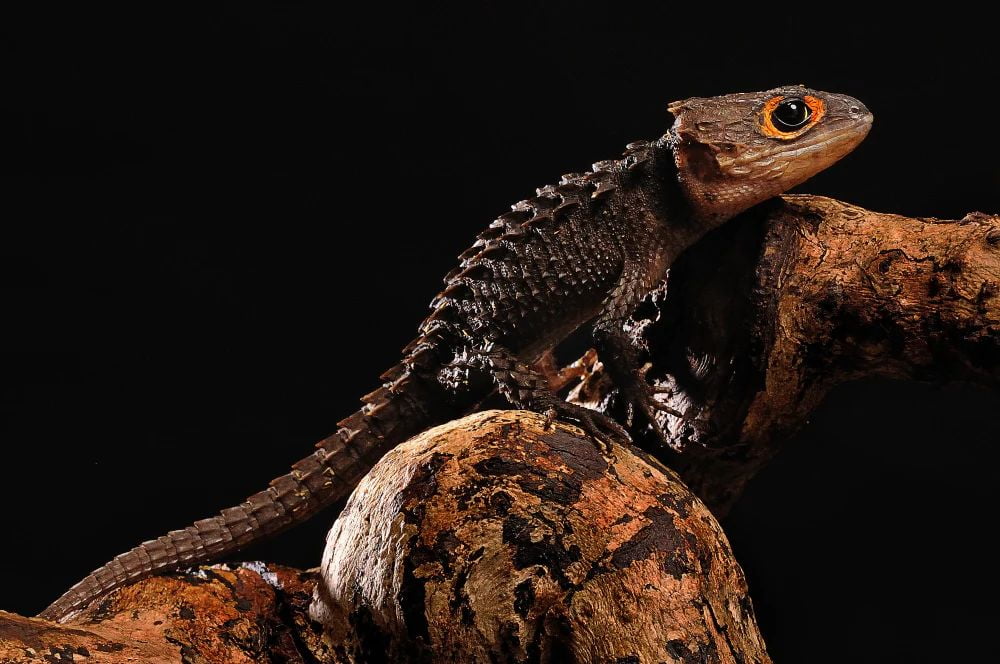
The Red-Eyed crocodile; also called the Red-Eyed crocodile skink, looks just like a mi
niature crocodile! It actually takes its common name from its armor-like scales that make it look surprisingly like a baby croc.
But this shy reptile rarely grows beyond 10 inches in length and has a tendency to yip and chirp when startled or frightened.
In this article, learn about Red-Eyed crocodile price and the common setup and maintenance costs.
Contents
Red-Eyed Crocodile Purchase Cost
Underground Reptiles has farm-bred Red-Eyed crocodiles for sale for $150 per 4” to 6” animal, while Backwater Reptiles offers medium/large Red-Eyed crocodiles for the same price.
On the other hand, Reptile City offers a choice of male or female Red-Eyed crocodile skinks for a cost of $250. Similarly, Tiki’s Geckos offers field-collected (wild caught) Red-Eyed crocodile skinks for $200.
What All Can Change The Final Quote?
- Shipping
Breeders offer different shipping rates depending on the value of your purchases. Underground Reptiles ships Red-Eyed croc skinks for $39 per order.
If you’re a busy bee or not at home during the day, Reptile City offers overnight shipping with variable processing times from $20 to $50 while Backwater Reptiles ships its reptiles for $45 overnight.
- Wild-caught versus farm-raised
Thankfully, the Red-Eyed crocodile is listed as a species of “least concern” on the IUCN endangered species list. You may find that wild-caught skinks are more expensive; although it is best for the species to purchase farm-raised crocs.

One-Time Red-Eyed Crocodile Costs
These are the most common initial costs to set up your Red-Eyed crocodile skink’s habitat.
- Terrarium – A 20-gallon aquarium-style habitat will work well for a single adult Red-Eyed crocodile. If you plan to house a pair (different gender only for their safety), add 10 gallons. You can buy aquarium at different retail stores with a starting price of $45 such as MarineLand Aquarium Standard Rectangular Glass Aquarium Black 20 Gallon High.
- Water dish – Water is important for drinking and humidity. Fluker’s corner water dish is a good choice at around $6.
- Feeding dish – Since you will be feeding mostly live prey, you want to provide a dish that makes escape challenging. Exo Terra’s worm dish is ideal at around $8.
- Hides – Red-Eyed crocodile skinks will mostly hide during the daylight hours. Hollowed-out coconut halves with a natural surface (around $9 for two) make a great hiding spot. Hollow cork bark hides are also popular at $10 a piece.
- Mister or fogger – Humidity in the 80 to 95 percent range is vital to health. A system like the Exo Terra Monsoon Solo High Pressure Misting System for approximately $80 offers programmable misting. A more economical option is the Zoo Med Reptile Fogger Terrarium Humidifier at less than $50.
- Heater – Your Red-Eyed crocodile skink is cold-blooded and will need some temperature variability inside the habitat to stay comfortable. As a tropical species, this reptile prefers temperatures to remain in the 70°F to 82°F (21°C to 28°C) range. A heater can be used to warm up the warm side of the habitat during the cold season. A simple method is to place a Zoo Med radiant heat pad (over $14) underneath the warm side of the habitat.
- Temperature and humidity gauges – You can use a simple analog or digital combination temperature and humidity gauge to keep tabs on your skink’s habitat. Zoo Med’s analog thermometer/humidity gauge is around $8 while its digital thermometer/humidity gauge is just slightly more expensive at over $10.
Ongoing Red-Eyed Crocodile Costs
The Red-Eyed crocodile is an insectivore – meaning, this petite reptile eats primarily insects in a wild setting. In captivity, live gut-loaded (nutritionally enriched) small prey is ideal.
Live small red worms, mealworms, crickets, and other prey will be appreciated. It is very important that the prey is small – half the size of the skink’s head or smaller to avoid choking.
Live small feeder crickets will cost around $7 per 100 piece, small live mealworms cost a little over $3.09 for the same quantity, and small live red wiggler worms are approximately $23 per 200 pieces.
As for the vitamins and supplements, calcium with D3 added can help ensure your pet can absorb sufficient calcium to build strong bones. Expect a price of around $4 for a 3-oz jar of Zoo Med Repti Calcium with D3 Reptile Supplement.
Reptile vitamin powder should be sprinkled on food along with the calcium/D3 as your exotic veterinary directs. Rep-Cal Herptivite powder costs around $10 per 3.3-oz jar.
Feeding gut-loaded small live insects should make up the rest of your pet’s nutrition unless your exotic veterinarian advises otherwise.
As for the Red-Eyed Crocodile’s health, you will definitely need an exotic veterinarian if your pet becomes injured or ill. Expect to pay between $20 and $80 per veterinary exam and an equal amount for any tests.
Tanks accessories also need to be taken into consideration when budgeting for your croc’s maintenance. You can get a variety pack of live plants starting at around $17 while large fake plants start at around $5 per piece.
For substrate, the best one for Red-Eyed crocodiles is a combination of layers that holds in humidity well. You can use Zoo Med Forest Floor bedding for over $30 for 24-quart pack. Zilla Jungle Mix is another good blend starting at $10 for 4-quart.
A top layer of New Zealand compressed sphagnum moss for about $13 per 150-gram bale which works well for holding in humidity.
- Lighting
Unlike many reptile pet species, the Red-Eyed crocodile skink is crepuscular (most active at dusk and dawn) and so this reptile doesn’t need supplementation with ultraviolet-B spectrum light.
The best lighting is a white light system used for helping with circadian rhythms. Exo Terra’s Day & Night 3-watt bulb system with self-adhesive base is less than $30.
Exo Terra also has a 1-watt Full Moon night light for around $25 that is designed to view nocturnal reptiles.
